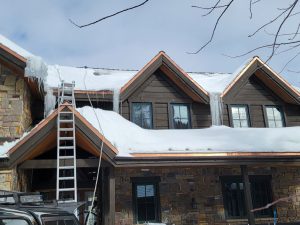Surviving Winter in Colorado: The Importance of Heat Tape in Commercial and Residential Roofing
As winter is here in Colorado, the weather becomes increasingly unpredictable. With temperatures fluctuating from below freezing to mild and back again, commercial and residential roofing is put to the test. It is during this time that the importance of heat tape becomes apparent. These small, yet essential components play a crucial role in ensuring the durability and longevity of a roof in Colorado’s unique winters.
Understanding the Role of Heat Tape in Commercial & Residential Roofing
Heat tape (also called heat trace cable) is a crucial component in residential and commercial roofing, especially in areas like Colorado where the weather can be extremely unpredictable. These small but powerful strips play a role in aiding in the longevity and functionality of a roof So, what exactly is the role of heat tape in roofing? Heat tape is designed to channel melted snow and ice that accumulates on the roof, preventing potential damage caused by the weight of the water and the formation of ice dams. Heat tape helps to maintain the structural integrity of the roof and prevent leaks and water damage inside the home.
The Mechanism of Heat Tape: How Do They Work?

Experience the importance of heat tape in residential roofing during harsh Colorado winters, preventing ice dams and safeguarding your home
Heat tape are small but powerful devices that play a crucial role in melting snow and ice on residential roofs. But how exactly do they work?
Ice dams are an inevitable occurrence, regardless of preventive measures. The sole purpose of installing heat tape on your roof is to facilitate the melting of a cavity at the base of the ice dam near the eave. This strategic intervention ensures that as the snow and ice transform into water and it remains within a heated space. The heat emanating from your home plays a pivotal role, causing the melted water to advance toward the eave. However, this progression is susceptible to refreezing when it encounters the colder exterior. The subsequent buildup of refrozen layers results in formidable ice dams, sometimes measuring up to 1’ – 2’ in thickness, trapping water and forming pools that pose potential risks. The eventual consequence may involve water seeping into the house.
Heat tape serves a crucial function by establishing a pathway at the lower edge of the ice dam, guiding the water toward the gutter. Its purpose is not to directly melt snow or ice dams; rather, it exclusively focuses on creating a channel for water to flow to the gutter. Resembling a snake, especially at the eave or valleys, the heat tape goes up and down. This design ensures that, regardless of where the ice dam manifests, the heat tape consistently generates an opening, effectively directing the water away from potential trouble spots.
Why Heat Tape is Not an Option in Colorado’s Fluctuating Weather
In Colorado’s fluctuating weather, heat tape is not just a luxury or optional feature for commercial and residential roofing – they are an absolute necessity. The unpredictable winter temperatures in Colorado can be extreme, with freezing temperatures one day and mild conditions the next. This constant fluctuation is what leads to the formation of ice dams and the accumulation of water on the roof, which can cause significant damage. Without heat tape, water can seep into the roof and cause leaks and water damage inside the home.
Hiring a Professional Roofing Company to Install Heat Trace Cable
When it comes to installing heat trace cables on your residential or commercial roof, it’s crucial to hire a professional roofing company. While some homeowners may consider attempting the installation themselves, it’s best left to the experts. A professional roofing company will have the experience and expertise to properly install the heat tape and ensure they are in proper working order. Roofing professionals are knowledgeable about the specific requirements for installing heat tape and will work alongside the electrician to power the system correctly. They understand the importance of installing the strips in key areas where ice dams are prone to form and can offer guidance on the best options for your specific roofing needs.
Additionally, hiring a professional roofing company for heat strip installation provides peace of mind. You can rest assured knowing that the installation will be done correctly and that the heat tape will effectively protect your roof during Colorado’s harsh winters.




You must be logged in to post a comment.